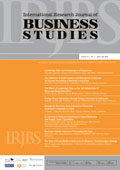Article Metrics |
|
|
Does Board Diversity Influence Financial Performance?
Abstract
This study extends the empirical evidence on the diversity on board and its impact to the financial performance in Indonesian context. Board diversity, as the independent variable uses three indicator variable of gender diversity, nationality diversity, and education diversity. Aside from traditional proportion measurement, Blau Index also used to measure the heterogeneity degree of each proxy of diversity in this study. This research is focused on the manufacturing companies since manufacturing industry is the largest contributor to the Indonesian GDP. The observation in this research including 525 firm-years from 105 listed manufacturing companies. The result of the study reveals that the heterogeneity in terms of nationality is beneficial for the company as it gives a positive impact to the financial performance measures, while gender and education heterogeneity is proven otherwise.
Full Text:
References
Adams, R., & Ferreira, D. (2004). Gender diversity in the boardroom. European Corporate Governance Institute. Finance Working Paper No. 58.
Agrawal, A., & Knoeber, C. (1996). Firm financial performance and mechanism to control agency problems between managers and shareholders. The Journal of Financial and Quantitative Analysis, 47(6), 377-397.
Ahern, K., & Dittmar, A. (2012). The changing of the boards: The impact on firm valuation of mandated female board representation. The Quarterly Journal of Economics, 137-197.
Al-Abbas, M. (2009). Corporate Governance and Earnings Management: an Empirical Study of the Saudi Market. The Journal of American Academy of Business, 15(1), 34-52.
Ararat, Aksu, & Cetin. (2010). Impact of board diversity on boards monitoring intensity and firm performance: Evidence from the Istanbul Stock Exchange. 17th Annual Conference of the Multinational Finance Society, 27-30 June, (pp. 43-67). Barcelona. Retrieved from http://papers.ssrn.com/sol3/papers.cfm?abstract_id=1572283
Asian Development Bank. (2013). ASEAN Corporate Governance Scorecard; Country Report and Assessment 2012-2013. . Asian Development Bank.
Barta, T., Kleiner, M., & Neumann, T. (2012). Is there a payoff from top-team diversity? McKinsey Quarterly, 13-15.
Bathula, H. (2008). Board characteristics and firm performance: Evidence from New Zealand. Journal of University of Technology Auckland, 12(5), 5-28.
Beasley, M. (1996). An empirical analysis of the relation between the board of director composition and financial statement fraud. The Accounting Review, 71(4), 443-465.
Blau, P. (1977). Inequality and Heterogeneity. New York: The Free Press.
BPS. (2016). National Income of Indonesia 2012-2016. Jakarta: Badan Pusat Statistik. Retrieved from https://www.bps.go.id/website/pdf_publikasi/Pendapatan-Nasional-Indonesia-2012---2016.pdf
Burmajster, A. (2009). The handbook of international corporate governance: A definitive guide. London: Kogan Page.
Campbell, K., & Minguez-Vera, A. (2008). Gender diversity in the boardroom and firm financial performance. Journal of Business Ethics, 83(3), 435-451.
Carpenter, M., & Westphal, J. (2001). The strategic context of external network ties: Examining the impact of director appointments on board involvement in strategic decision making. Academy of Management Journal, 44(4), 639-660.
Carter, D. A., Simkins, B. J., & Simpson, W. G. (2003). Corporate Governance, Board Diversity, and Firm Value. The Financial Review, 38(1), 33-53.
Choi, Park, & Yoo. (2007). The value of outside directors: evidence from corporate governance reform in Korea. Journal of Financial and Quantitative Analysis, 42(4), 941-962.
Chung, K., & Pruitt, S. (1994). A Simple Approximation of Tobin's q. Financial Management, 23(3), 70-74.
Coffey, B., & Wang, J. (1998). Board diversity and managerial control as predictors of corporate social performance. Journal of Business Ethics, 17(4), 1595-1603.
Cox, Jr., T. (1991). The multicultural organization. Academy of Management Executive, 5(2), 34-47.
Cox, T., & Blake, S. (1991). Managing cultural diversity: implications for organizational competitiveness. Academy of Management Executive, 5(3), 45-56.
Darmadi, S. (2010). Board diversity and. MPRA, 1(1), 1-38.
Dimitropoulos, P. (2014). Capital structure and corporate governance of soccer clubs: European evidence. Management Research Review, 37(7), 658-678.
Dobbin, F., & Jung , J. (2011). Corporate board gender diversity and stock performance: The competence gap or institutional investor bias. North Carolina Law Review, 89(3), 809-839.
Earley, C., & Mosakowski, E. (2000). Creating hybrid team cultures: an empirical test of transactional team. Academy of Management Journal, 43(1), 26-49.
Enekwe, Agu, & Eziedo. (2014). The Effect of Financial Leverage on Financial Performance:Evidence of Quoted Pharmaceutical Companies in Nigeria. IOSR Journal of Economics and Finance (IOSR-JEF), 5(3), 17-25.
Erhardt, N., Werbel, J., & Shrader, C. (2003). Board of director diversity and firm financial performance. Corporate Governance: An International Review, 11(2), 102-111.
Farrell, K., & Hersch, P. (2005). Additions to corporate boards: The effect of gender. Journal of Corporate Finance,11(2), 85-106.
Fidanoski, F., Simeonovski, K., & Mateska, V. (2014). The impact of Board Diversity on Corporate Performance: New Evidence from Southeast Europe. Corporate Governance in the US and Global Settings, 17(2), 81-123.
Fidanoski, Mateska, & Simeonovski. (2014). Corporate governance and bank performance: Evidence from Macedonia. Economic Analysis, 47(2), 76-99.
Gill, A., & Obradovich, J. (2012). The Impact of Corporate Governance and Financial Leverage on the Value of American Firms. International Research Journal of Finance and Economics, 91(1), 1-14.
Goodstein, J., Gautam, K., & Boeker, W. (1994). The Effect of Board Size and Diversity on Strategic Change. Strategic Management Journal, 15(3), 241-250.
Gordini, N., & Rancati, E. (2017). Gender Diversity in the Italian boardroom and firm financial performance. Management Research Review, 40(1), 75-94.
Hambrick, D., Cho, T., & Chen, M. (1996). The influence of top management team heterogeneity on firms competitive moves. Administrative Science Quarterly, 41(4), 659-684.
Hart, O. (1993). Theories of capital structure: a managerial discretion perspective. (M. Blair, Ed.) Washington, DC: Brookings Institiution.
Hermalin, B., & Weisbach, M. (1991). The effects of board composition and direct incentives on firm performance. Financial Management, 20(4), 101-112.
Herrmann, P., & Datta, D. (2005). Relationships between top management team characteris and international diversification: An empirical investigation. British Journal of Management, 16(1), 69-78.
Hilmer, F. (1998). Strictly boardroom: Improving governance to enhance company performance. Melbourne: Information Australia.
Hurst, D., Rust, J., & White, R. (1989). Top management teams and organizational framework. Academy of Management Review, 10(1), 87-105.
IDX. (2017). Manufacturing Sector. Retrieved from idx.co.id: http://www.idx.co.id/id-id/beranda/perusahaantercatat/laporankeuangandantahunan.aspx
Ingley, C., & van der Walt, N. (2001). The strategic board: The changing role of directors in developing and maintaining corporate capability. Corporate Governance: An International Review, 9(3), 174-185.
Jensen, M. C., & Meckeling, W. H. (1976). Theory of The Firm: Managerial Behaviour, Agency Cost, and Ownership Structure. Journal of Financial Economics, 3(4), 305-360.
Jianakoplos, N., & Bernasek, A. (1998). Are women more risk averse? Economic Enquiry, 36(4), 620-630.
Kapoor, S. (2017). Manufacturing at glance. Journal of Manufacturing Processes, 23(1), 40-59.
Kilduff, M., Angelmar, R., & Mehra, A. (2000). Top Management-Team Diversity and Firm Performance: Examining the Role of Cognitions. Organization Science, 11(1), 21-34.
Kilic, M., & Kuzey, C. (2016). The effect of board gender diversity on firm performance: evidence from Turkey. Gender in Management: An International Journal, 31(7), 434-455.
Kini, O., Kracaw, W., & Mian, S. (1995). Corporate takeovers, firm financial performance, and board composition. Journal of Corporate Finance, 1(1), 383-412.
Kumar, P., & Zattoni, A. (2013). Corporate Governance, Board of Directors, and Firm Performance. Corporate Governance: An International Review.
Lang, L., Stulz, R., & Walkling, R. (1989). Managerial performance, Tobin's Q, and the gains from successful tender offers. Journal of Financial Economics, 24(1), 137-154.
Lehman, C., & Dufrene, D. (2008). Business Communication 15th Edition. Mason: Thomson South-Western.
MacAvoy, P., & Millstein, I. (1999). The active board of directors and its effect on the The active board of directors and its effect on the. Journal of Applied Corporate Finance, 11(4), 8-20.
Mahadeo, J., Soobaroyen, T., & Hanuman, V. (2012). Team-based employee involvement programs: Effects of design and administration. Personnel Psychology, 105(3), 375-388.
Masa'deh, R., Mohammad, T., Jarrah, I., & Tarhini, A. (2015). Accounting vs. Market-based Measures of Firm Performance Related to Information Technology Investments. International Review of Social Sciences and Humanities, 9(1), 129-145.
Masulis , R., Wang, C., & Xie, F. (2012). Globalizing the boardroom: the effects of foreign directors on corporate governance and firm financial performance. Journal of Accounting and Economics, 53(1), 527-554.
Mensi-Klarbach, H. (2014). Gender in top management research: towards a comprehensive research framework. Management Research Review, 37(6), 538-552.
Milliken, F., & Martins, L. (1996). Searching for Common Threads: Understanding the Multiple Effects of Diversity in Organizational Groups. The Academy of Management Review, 21(6), 402-433.
Ntim, C. (2015). Board diversity and organizational valuation: unraveling the effects of enthnicity and gender. Journal of Management and Governance, 1(1), 167-195.
Obonyo, R. (2015). The Effects Of Financial Leverage On Financial Performance Of Listed Companies at The Nairobi Securities Exchange in Kenya. Researchjournalis Journal of Finance, 3(1), 1-20.
OECD. (2017). OECD survey of corporate governance frameworks in Asia.
Omar, A., & Davidson, M. (1989). Women in management: a comparative cross-cultural overview. Cross Cultural Management: An International Journal, 8(4), 35-67.
Oxelheim, L., & Randoy, T. (2003). The impact of foreign board membership on firm value. Journal of Banking & Finance, 27(12), 2369-2392.
Rhode, D., & Packel, A. (2010). Diversity on corporate boards: How much difference does difference make. Rock Center for Corporate Governance at Stanford University, Social Science Research Network. Retrieved from http://papers.ssrn.com/sol3/papers.cfm?abstract_id=1685615
Rose, C. (2007). Does female board representation influence firm financial performance? The Danish evidence. Corporate Governance: An International Review, 15(2), 404-413.
Ruigrok, W. (2009). Nationality, international experience diversity and firm internationalisation: The implications for performance. Journal of University of St. Gallen, 2(1), 21-45.
Smith, N., Smith, V., & Verner, M. (2006). Do women in top management affect firm performance? A panel study of 2,500 Danish firms. International Journal of Productivity and Performance Management, 55(7), 569-593.
Sujoko, & Soebiantoro, U. (2009). Metodelogi Penelitian Kuantitatif, Kualitatif dan R&D. Bandung: Alfabeta.
Tihanyi, L., Ellstrand, A., Daily, C., & Dalton, D. (2000). Composition of the top management team and firm international diversification. Journal of Management, 26(6), 1157-1177.
Ujinwa, A., Okoyeuzu, C., & Nwokoby, I. (2012). Corporate board diversity and firm performance: Evidence from Nigeria. Review of International Comparative Management, 13(4), 605-620.
Velnampy, T. (2013). Corporate Governance and Firm Performance: A Study of Sri Lankan Manufacturing Companies. Journal of Economics and Sustainable Development, 4(3), 2222-2855.
Virtanen, O. (2009). The handbook of international corporate governance: A definitive guide. (F. I. Directors, Ed.) London: Kogan Page.
Wahid, A. (2012). Director heterogenity and its impact on board effectiveness. Journal of University of Harvard, 13(1), 35-50.
Waine, P., & Green , H. (2012). Directors heterogeneity and its impact on board effectiveness. (I. I. Directors, Ed.) London: Kogan Page.
Weimer, J., & Pepe, J. (1999). A Taxonomy of Systems of Corporate Governance. Corporate Governance: An International Review, 7(2), 152-166.
White, G., Sondhi, A., & Fried, D. (2003). The Analysis and Use of Financial Statements, 3rd Edition. New York: Wiley.
Williams, K., & O'Reilly, C. (1998). Demography and diversity in organizations: a review of 40 years of research. Research in Organizational Beavior, 20(1), 77-140.
Wynarczyk, P. (2007). Addresing the "gender gap" in the managerial labour market: the case of scientific and medium-sized enterprises (SMEs) in the North East of Enland. Management Research Review, 30(12), 942-954.
Copyright (c) 2018 Josua Tarigan, Christoforus Hervindra, Saarce Elsye Hatane
International Research Journal of Business Studies has been covered by the following services: | ||||||||||||||||||||||||
|




















